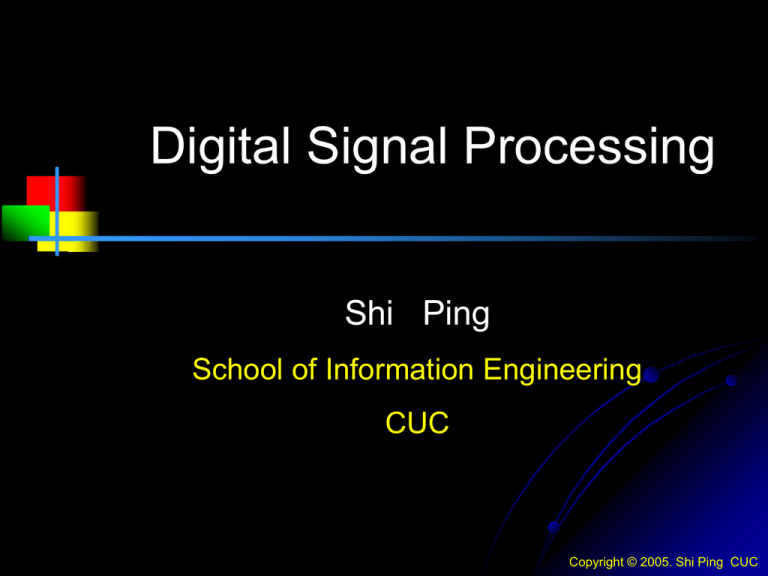Digital Signal Processing
advertisement

Digital Signal Processing Shi Ping School of Information Engineering CUC Copyright © 2005. Shi Ping CUC Course outline Text books : 《数字信号处理教程》 (第三版) 清华大学出版社,程佩青 2006年 Reference books: <Digital Signal Processing Using MATLAB> 英文影印版 科学出版社 Vinay K. Ingle John G. Proakis 2003 Copyright © 2005. Shi Ping CUC Course outline Reference books: 王世一 《数字信号处理》北京理工大学出版 社,1997年 A.V.奥本海姆 R.W.谢弗 J.R.巴克 编著 刘树 堂 黄建国 译《离散时间信号处理》(第2版) 西安交通大学出版社 2001年 胡广书《数字信号处理-理论、算法与实现》 (第二版)清华大学出版社2003年 Copyright © 2005. Shi Ping CUC Course outline Relationship with other courses About MATLAB Software Requirements Copyright © 2005. Shi Ping CUC Chapter 1 Introduction to DSP Content Signal, System, Signal Processing The Constitution of DSP System How to implement the DSP The Application of DSP The advantages of DSP Copyright © 2005. Shi Ping CUC Signal, System, Signal Processing Signal A signal is a function of independent variables such as time, distance, position, temperature and pressure Signals play an important role in our daily life. Most signals we encounter are generated naturally. However, a signal can also be generated synthetically or by a computer. Depending on the nature of the independent variables and the value of the function, we can classify the signals as follows Copyright © 2005. Shi Ping CUC Signal, System, Signal Processing ● scalar signal A signal generated by a single source ● vector signal (or multichannel signal) A signal generated by multiple sources ● one dimensional (1-D) signal A function of a single independent variable ● multidimensional (M-D) signal A function of more than one independent variables sound Image Video Copyright © 2005. Shi Ping CUC Signal, System, Signal Processing ● continuous-time signal x(t ) see The independent variable is continuous ● discrete-time signal (sequence) x(n) The independent variable is discrete ● analog signal A continuous-time signal with a continuous amplitude ● quantized-boxcar signal A continuous-time signal with a discrete-value amplitude ● digital signal A discrete-time signal with a discrete-value amplitude ● Sampled-data signal A discrete-time signal with a continuous amplitude Copyright © 2005. Shi Ping CUC Signal, System, Signal Processing ● deterministic signal A signal that can be uniquely determined by a well-defined process, such as a mathematical expression or rule, or table look-up. ● random signal A single that is generated in a random fashion and cannot be predicted ahead of time. Copyright © 2005. Shi Ping CUC Signal, System, Signal Processing ● periodic signal A signal that repeats itself in a periodic fashion from negative to positive infinity. x( t ) x( t kT ) x( n) x( n kN ) ● aperiodic signal A signal that extends to both positive and negative infinity without repeating in a periodic pattern. Copyright © 2005. Shi Ping CUC Signal, System, Signal Processing ● power signal An infinite energy signal with finite average power. 1 P lim T T T 0 2 x ( t ) dt 1 P lim N N N 1 x ( n) 2 n 0 ● energy signal An finite energy signal with zero average power. E 2 x( t ) dt E x ( n) 2 a periodic sequence — power signal a finite-length sequence — energy signal Copyright © 2005. Shi Ping CUC Signal, System, Signal Processing System A system is any process that produces an output signal in response to an input signal. Depending on the types of the signal processed, we can classify the systems as follows: Copyright © 2005. Shi Ping CUC Signal, System, Signal Processing ● analog system input and output analog signals ● digital system input and output digital signals ● continuous-time system input and output continuous-time signals ● discrete-time system input and output discrete-time signals Copyright © 2005. Shi Ping CUC Signal, System, Signal Processing Signal Processing A signal carries information ! The objective of signal processing: To extract, enhance, store and transmit the useful information carried by the signal. Digital signal processing: To implement the signal processing by a digital means. return Copyright © 2005. Shi Ping CUC The Constitution of DSP System Equivalent to an analog signal processor analog analog PrF ADC DSP DAC PoF waveform PrF: antialiasing filtering example PoF: smooth out the staircase waveform return Copyright © 2005. Shi Ping CUC How to Implement the DSP To handle the DSP algorithms in a general-purpose microprocessor by means of software programming To handle the DSP algorithms in a specifically designed Digital Signal Processors (DSPs) return Copyright © 2005. Shi Ping CUC The Application of DSP The main tasks of DSP Signal Analysis Measurement of signal properties Spectrum (frequency/phase) analysis Target detection, verification, recognition Signal Filtering Signal-in-signal-out, filter Removal of noise/interference Separation of frequency bands Copyright © 2005. Shi Ping CUC The Application of DSP DSP application examples Telecommunications Multiplexing Compression Echo control Audio Processing Music Speech generation Speech recognition Copyright © 2005. Shi Ping CUC The Application of DSP DSP application examples Echo Location Radar Sonar Reflection seismology Image Processing Medical Space Commercial Imaging Products Copyright © 2005. Shi Ping CUC The Application of DSP Demonstration FM synthesis of sound chirp clarinet brass bell Digital image processing Deblurring Edge detection Noise reduction return Copyright © 2005. Shi Ping CUC The Advantages of DSP Absence of drift in the filter characteristics Improved quality level Reproducibility Ease of new function development Multiplexing Modularity Total single chip implementation using VLSI technology return Copyright © 2005. Shi Ping CUC The sound signal is an example of a 1-D signal where the independent variable is time return Copyright © 2005. Shi Ping CUC A black-and-white image signal is an example of a 2-D signal where the 2 independent variables are the 2 spatial variables. I ( x, y) Copyright © 2005. Shi Ping CUC A color image signal is a 3-channel signal composed of three 2-D signals representing the three primary color: red, green and blue (RGB) I R ( x , y ) u( x , y ) I G ( x , y ) I G ( x , y ) return Copyright © 2005. Shi Ping CUC A black-and-white video signal is an example of a 3-D signal where the 3 independent variables are the 2 spatial variables and the time variable. I ( x, y, t ) Copyright © 2005. Shi Ping CUC A color video signal is a 3-channel signal composed of three 3-D signals representing the three primary color: red, green and blue (RGB) I R ( x , y , t ) u( x , y , t ) I G ( x , y , t ) I B ( x , y , t ) return Copyright © 2005. Shi Ping CUC 1 1 0.9 1 1 0.9 0.8 0.8 0.9 0.9 0.7 0.7 0.8 0.8 0.6 0.6 0.7 0.7 0.5 0.5 0.6 0.6 0.4 0.4 0.5 0.5 0.3 0.3 0.4 0.4 0.2 0.2 0.3 0.3 0.1 0.1 0.2 0.2 0 0 0.1 0.1 -0.1 0 0 -0.1 -0.2 -0.2 -0.1 -0.1 -0.3 -0.3 -0.2 -0.2 -0.4 -0.4 -0.3 -0.3 -0.5 -0.5 -0.4 0 -0.4 0 -0.5 -0.5 0 0 1 1 0.9 0.9 1 1 0.8 0.8 0.9 0.9 0.7 0.7 0.8 0.8 0.6 0.6 0.7 0.7 0.5 0.5 0.6 0.6 0.4 0.4 0.5 0.5 0.3 0.3 0.4 0.4 0.2 0.2 0.3 0.3 0.1 0.1 0.20 0.2 0 0.1 0.1 -0.1 -0.1 0 0 -0.2 -0.2 -0.1 -0.1 -0.3 -0.3 -0.2 -0.2 -0.4 -0.4 -0.3 -0.3 -0.4 0 -0.4 0 10 10 10 10 10 10 20 20 20 20 20 20 30 30 30 30 1 1 0.9 1 0.91 0.8 0.9 0.9 0.8 0.7 0.7 0.8 0.8 0.6 0.6 0.7 0.7 0.5 0.5 0.6 0.6 0.4 0.4 0.5 0.5 0.3 0.3 0.4 0.4 0.2 0.2 0.3 0.3 0.1 0.1 0.2 0.2 0 0 0.1 0.1 -0.1 0 -0.10 -0.2 -0.1 -0.1 -0.2 -0.3 -0.3 -0.2 -0.2 -0.4 -0.4 -0.3 -0.3 -0.5 -0.5 -0.4 0-0.40 -0.5 -0.5 0 0 10 10 10 10 20 20 20 20 30 30 30 30 30 30 1 1 0.9 0.9 1 0.81 0.8 0.9 0.9 0.7 0.7 0.8 0.8 0.6 0.6 0.7 0.7 0.5 0.5 0.6 0.6 0.4 0.4 0.5 0.5 0.3 0.3 0.4 0.4 0.2 0.2 0.3 0.3 0.1 0.1 0.20 0.2 0 0.1 0.1 -0.1 -0.1 0 -0.20 -0.2 -0.1 -0.1 -0.3 -0.3 -0.2 -0.2 -0.4 -0.4 -0.3 -0.3 -0.4 0-0.40 10 10 20 20 30 30 Copyright © 2005. Shi Ping CUC return 8 4 6 3 4 2 2 1 0 0 10 20 30 40 50 0 8 4 6 3 4 2 2 1 0 0 10 20 30 40 50 0 8 4 6 3 4 2 2 1 0 0 10 20 30 40 50 0 0 10 20 30 40 50 0 10 20 30 40 50 0 10 20 30 40 50 return Copyright © 2005. Shi Ping CUC Original Image Restored Image Blurred Image return Copyright © 2005. Shi Ping CUC return Copyright © 2005. Shi Ping CUC return Copyright © 2005. Shi Ping CUC


![John McDonald, Director, Claremont Colleges Library [PPT]](http://s2.studylib.net/store/data/005395875_1-1935e1d320e49e3ca4701d9a87404d36-300x300.png)



